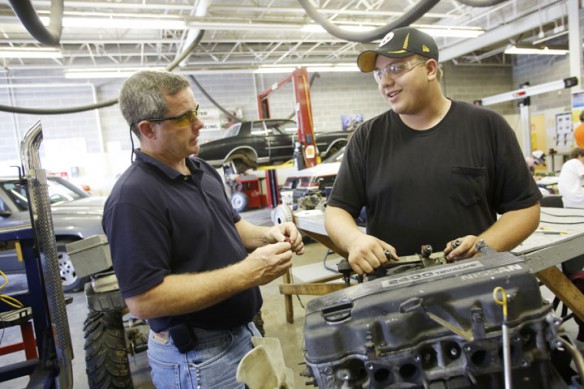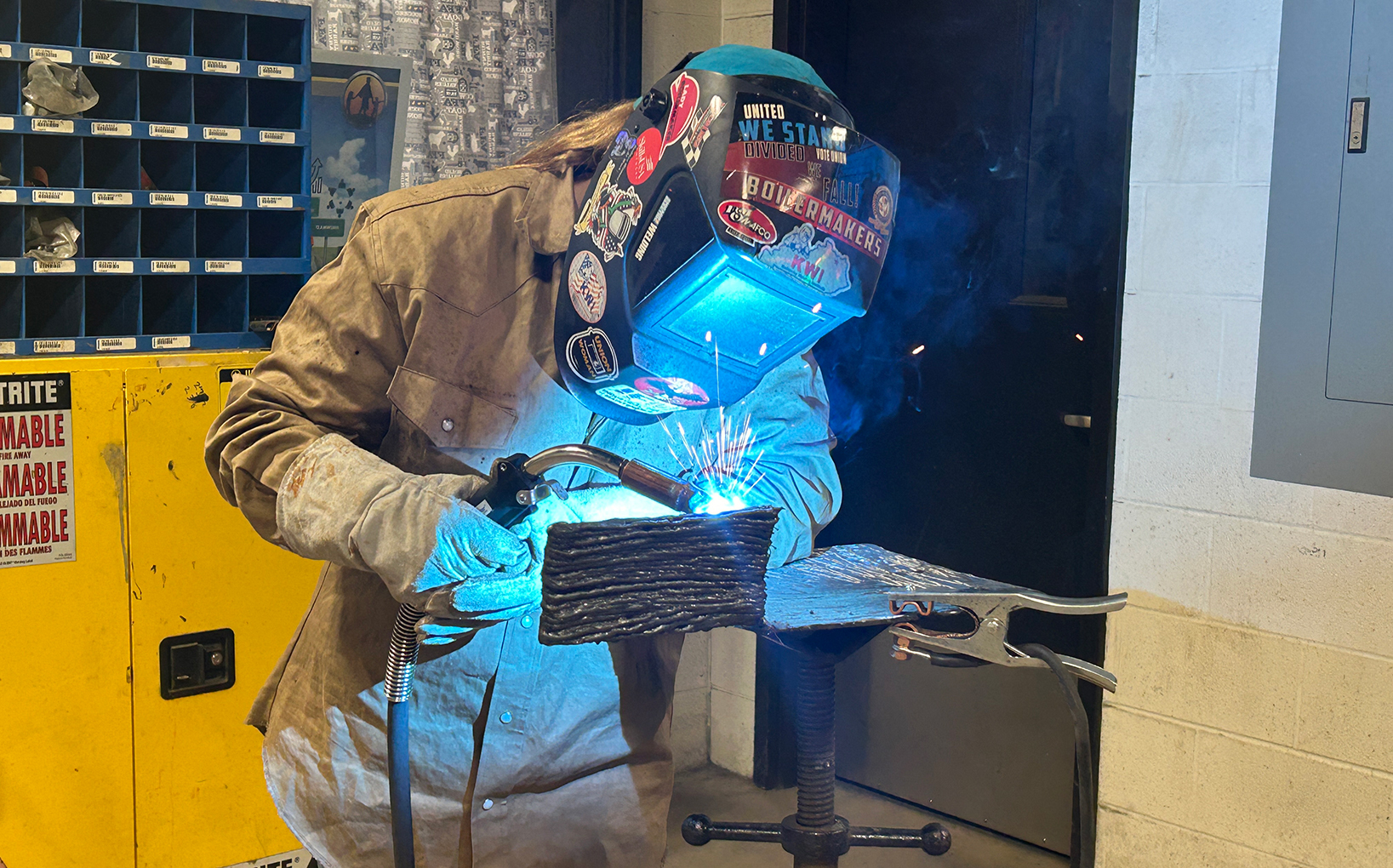
Brian Dugan talks fuel injectors with Bullitt County CRC junior Corey Ivy in the automotive lab at the Bullitt County Area Technology Center. Ivy would like to open an automotive shop one day. Photo by Amy Wallot, Sept. 5, 2012
By Susan Riddell
susan.riddell@education.ky.gov
Rick Dawson, a counselor at the Bullitt County school district’s Career Readiness Center (CRC), has worked over the years with many students who struggled in a traditional classroom setting.
Some struggled to focus in a lecture-type setting that didn’t offer more hands-on learning, he said. Others struggled with formative and summative assessments.
“That environment just isn’t an easy place for some to thrive,” said Dawson.
That’s where Bullitt County’s Career Readiness Center can make the difference. The center, in its second year, provides students with a different approach to learning and gives the district a means to better prepare students for careers.
“These kids want to learn, and we’re a good fit where that pressure isn’t there,” Dawson said. “We want them to come back every day and to enjoy being here.”
In February 2011, the Kentucky Department of Education (KDE) secured the Commonwealth Commitment from all districts to move 50 percent of their district’s high school graduates who are not college- and/or career-ready to college- and/or career-ready between 2010 and 2015. KDE’s Unbridled Learning initiative outlines the plans, strategies and milestones set forth to make this vision a reality.
In Bullitt County, school officials have taken that goal to heart, and are requiring all students be either college or career ready to graduate, starting in 2015.
With that in mind, Brady Southwood, principal of the Bullitt County Area Technology Center, said the Career Readiness Center provides another option for students to meet these requirements.
Laura Arnold, branch manager with KDE’s Office of Career and Technical Education, said the course work of the CRC along with the courses and collaboration of the ATC, gives students the opportunity to select a specific career and technical education (CTE) pathway.
“(That’s) the first step in achieving career readiness,” Arnold said. “One portion of Kentucky’s career readiness accountability model recognizes preparatory CTE students who have received industry certifications or Kentucky Occupational Skill Standards Assessments (KOSSA) certificates.
“A preparatory student is one who has completed two CTE credits within a specific pathway and is enrolled in the third credit,” Arnold added. “The Bullitt County model allows students to identify their pathways early, so they can complete the necessary courses required to obtain the skills and certifications for future career success.”
Southwood said the CRC is particularly effective for freshmen who can immediately begin technical courses they otherwise would have taken as juniors or seniors at the district’s Area Technology Center.
“Most times students who could really use this setting get behind on core credits or drop out before getting the chance to do the technical, hands-on learning that they need in order to be successful,” Southwood said.
Students at the CRC are split into two groups. One group is freshmen, and the other group combines students in grades 10-12. There are about 60 students in all.
Students spend half of each day in their technical field of choice: welding, nursing, graphic design, mechanics or health sciences at the district area technology center. The remaining half of the day, they take academic courses through Compass Learning Odyssey and APEX at the Riverview Opportunity Center.
Melissa Fox taught and facilitated these online courses last year along with tutors and an instructional assistant before moving into the TAPP program this year. She said students responded well to this format, especially being in an environment that was more 1:1 than a traditional classroom.
“Many students said it helped them get through classes they hated,” said Fox, who added that students benefitted from knowing they were earning credits they wouldn’t otherwise get. “This program gives students a sense of pride.
“Not all students learn by sitting in a classroom,” Fox added. “It’s important to make sure that every school is reaching out to every student. This program reaches out to students who could possibly drop out of high school, but now they want to succeed and finish.”
To participate in the CRC, students applied by writing a short on-demand essay explaining why they wanted to join the program. Each student also needed a teacher’s letter of recommendation, a successful interview and a reading MAP score of 216 or higher. Administrators spoke to all 8th graders last spring to make sure they were aware of the CRC option.
Southwood said that while potential dropouts were obviously interested in the program, so were many students who were already thriving in traditional classrooms.
In addition to their core and technical classes, CRC students also are engaged in life skills lessons that teach how them to balance a checkbook and how to apply for a loan, along with other financial literacy readiness curriculum.
When students are not working on their online core courses or out in the technical classrooms, they are meeting individually with Dawson, who counsels each one to make sure they are on pace in both components.
“I know every child by name,” Dawson said. “I can help schedule classes or advise them in any way.”
Dawson said students took multiple field trips last year in their specific areas of interest, and the community partners have played a big role in the success of the center.
“Students have been to job sites and businesses,” he said. “Our nursing students have watched an open-heart surgery and visited nursing homes and maternity wards. There were several chances for our welders and carpenters to go out in the field.”
Dawson said he would like to see these experiences translate to educational co-ops in the future.
“We want to sell the ideas of the CRC to the businesses and create opportunities for our students,” he said. “We want businesses to work with them, and then hire them back because they are such good workers.”
In its first year, the Career Readiness Center was open to mainly freshmen and sophomores, but a few interested juniors were allowed to participate. That gives the CRC a handful of seniors this year, and Dawson said they will be monitored post-graduation to gauge the success of the program. Each student will go through an exit interview, and Dawson hopes to meet with each graduate a year later to see what struggles and successes they’ve had, either in college or the workplace.
“There’s no doubt we want to expand the readiness center, and tracking these kids will be an awesome opportunity to make improvements,” Dawson said. “We definitely think we’ve got something great here, and we want to make it even better.”
MORE INFO …
Rick Dawson, rick.dawson@bullitt.kyschools.us, (502) 543-1884








Leave A Comment